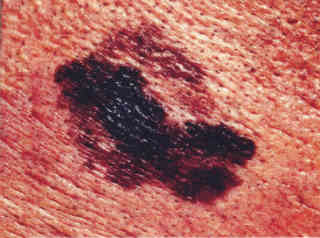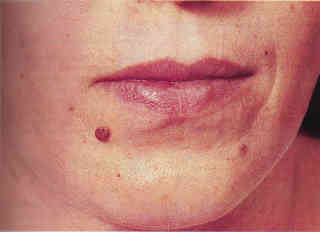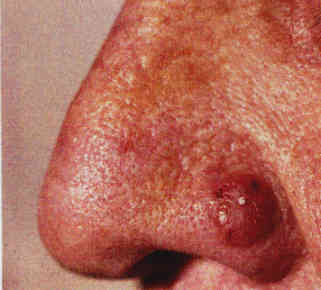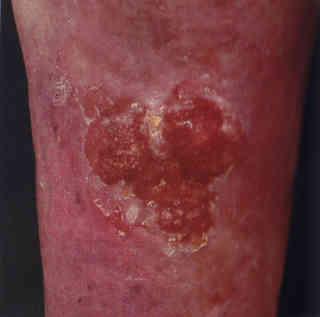Skin Cancer Treatment

Skin cancer is the most common form of cancer in the United States. More than 500,000 new cases are reported each year–and the incidence is rising faster than any other type of cancer. While skin cancers can be found on any part of the body, about 80 percent appear on the face, head, or neck, where they can be disfiguring as well as dangerous.
Dr. Legere regularly gives skin consults, where she will look for lesions that may be suspicious. She can and does biopsy such lesions in the office. Once the pathology report is received, she is then able to determine if the lesion needs to be removed. She then removes the pre-cancerous and cancerous lesions in the office, using only local anesthesia.
The primary cause of skin cancer is ultraviolet radiation–most often from the sun, but also from artificial sources like sunlamps and tanning booths. In fact, researchers believe that our quest for the perfect tan, an increase in outdoor activities, and perhaps the thinning of the earth’s protective ozone layer are behind the alarming rise we’re now seeing in skin cancers.
Anyone can get skin cancer–no matter what your skin type, race, or age, no matter where you live or what you do. But your risk is greater if…
- Your skin is fair and freckles easily.
- You have light-colored hair and eyes.
- You have a large number of moles, or moles of unusual size or shape.
- You have a family history of skin cancer or a personal history of blistering sunburn.
- You spend a lot of time working or playing outdoors.
- You live closer to the equator, at a higher altitude, or in any place that gets intense, year-round sunshine.
- You received therapeutic radiation treatments for adolescent acne.
Types of Skin Cancer
By far the most common type of skin cancer is basal cell carcinoma. Fortunately, it’s also the least dangerous kind — it tends to grow slowly, and rarely spreads beyond its original site. Though basal cell carcinoma is seldom life-threatening, if left untreated it can grow deep beneath the skin and into the underlying tissue and bone, causing serious damage (particulary if it’s located near the eye).
Squamous cell carcinoma is the next most common kind of skin cancer, frequently appearing on the lips, face, or ears. It sometime spreads to distant sites, including lymph nodes and internal organs. Squamous cell carcinoma can become lift threatening if it’s not treated.
A third form of skin cancer, malignant melanoma, is the least common, but its incidence is increasing rapidly, especially in the Sunbelt states. Malignant melanoma is also the most dangerous type of skin cancer. If discovered early enough, it can be completely cured. If it’s not treated quickly, however, malignant melanoma may spread throughout the body and is often deadly.

Other Skin Growths You Should Know About
Two other common types of skin growths are moles and keratoses.
Moles are clusters of heavily pigmented skin cells, either flat or raised above the skin surface. While most pose no danger, some — particularly moles present at birth, or those with mottled colors and poorly defined borders — may develop into malignant melanoma. Moles are frequently removed for cosmetic reasons, or because they’re constantly irritated by clothing or jewelry (which can sometimes cause pre-cancerous changes).


Solar or actinic keratoses are rough, red or brown, scaly patches on the skin. They are usually found on areas exposed to sun, and sometimes develop into squamous cell cancer.

Recognizing Skin Cancer
Basal and squamous cell carcinomas can vary widely in appearance. The cancer may begin as a small, white or pink nodule or bump; it can be smoth and shiny, waxy, or pitted on the surface. Or it might appear as a red spot that’s rough, dry, or scaly…a firm, red lump that may form a crust…a crusted group of nodules…a sore that bleeds or doesn’t heal after two to four weeks…or a white patch that looks like scar tissue.
Malignant melanoma is usually signaled by a change in the size, shape, or color of an existing mole, or as a new growth on normal skin. Watch for the “ABCD” warning signs of melanoma: Asymmetry — a growth with unmatched halves; Border irregularity — ragged or blurred edges; Color — a mottled appearance, with shades of tan, brown, and black, sometimes mixed with red, white, or blue; Diameter — a growth more than 6 millimeters (about the size of a pencil eraser), or any unusual increase in size.
If all these variables sound confusing, the most important thing to remember is this: Get to know your skin and examine it regularly, from the top of your head to the soles of your feet. (Don’t forget your back.) If you notice any unusual changes on any part of your body, have a doctor check it out.
Choosing a Doctor
If you’re concerned about skin cancer, your family physician is a good place to start. He or she should examine your skin at your annual physical, and can refer you to a specialist if necessary.
If you notice an unusual growth yourself, consult a plastic surgeon or a dermatologist. Both are skilled at diagnosing and treating skin cancer and other skin growths. A plastic surgeon can surgically remove the growth in a manner that maintains function and offers the most pleasing final appearance — a consideration that my be especially important if the cancer is in a highly visible area. If a treatment other than surgical excision is called for, the plastic surgeon can refer you to the appropriate specialist.
Diagnosis and Treatment
Skin cancer is diagnosed by removing all or part of the growth and examining its cells under a microscope. It can be treated by a number of methods, depending on the type of cancer, its stage of growth, and its location on your body.
Most skin cancers are removed surgically, by a plastic surgeon or a dermatologist. If the cancer is small, the procedure can be done quickly and easily, in an outpatient facility or the physician’s office, using local anesthesia. The procedure may be a simple excision, which usually leaves a thin, barely visible scar.
If the cancer is large, however, or if it has spread to the lymph glands or elsewhere in the body, major surgery may be required. Other possible treatments for skin cancer include cryosurgery (freezing the cancer cells), radiation therapy (using x-rays), and topical chemotherapy (anti-cancer drugs applied to the skin).
Discussing Your Options And Concerns
All of the treatments mentioned above, when chosen carefully and appropriately, have good cure rates for most basal cell and squamous cell cancers — and even for malignant melanoma, if it’s caught very early, before it’s had a chance to spread.
You should discuss these choices thoroughly with your doctor before beginning treatment. Find out which options are available to you…how effective they’re likely to be for your particular cancer…the possible risks and side effects…who can best perform them…and the aesthetic and functional results you can expect. If you have doubts about the outcome, get a second opinion from a plastic surgeon before you begin treatment.
A Word About Reconstruction
The different techniques used in treating skin cancers can be life saving, but they may leave a patient with less than pleasing cosmetic or functional results. Depending on the location and severity of the cancer, the consequences may range from a small but unsightly scar to permanent changes in facial structures such as your nose, ear, or lip.
In such cases, no matter who performs the initial treatment, the plastic surgeon can be an important part of the treatment team. Reconstructive techniques–ranging from a simple scar revision to a complex transfer of tissue flaps from elsewhere on the body–can often repair damaged tissue, rebuild body parts, and restore most patients to acceptable appearance and function.
Preventing A Recurrence
After you’ve been treated for skin cancer, your doctor should schedule regular follow-up visits to make sure the cancer hasn’t recurred.
Your physician, however, can’t prevent a recurrence. It’s up to you to reduce your risks by changing old habits and developing new ones. (These preventative measures apply to people who have not had skin cancer as well.)
- Avoid prolonged exposure to the sun, especially between 10a.m and 2pm.m and during the summer months. Remember, ultraviolet rays pass right through water and clouds, and reflect off sand and snow.
- When you do go out for an extended period of time, wear protective clothing such as wide-brimmed hats and long sleeves.
- On any exposed skin, use a sunscreen with an SPF (sun protection factor) of at least 15. Apply it liberally, about an hour before you go out, and reapply it frequently, especially after you’ve been swimming or sweating.
- Finally, examine your skin regularly. If you find anything suspicious, consult a plastic surgeon or a dermatologist as soon as possible.
In addition, Dr. Legere also removes moles and skin tags from the body. However, in most instances, there is no “medical necessity” for those to be removed, so the removal of these types of lesions would be considered cosmetic. If there is no threat to harming the body, insurance will not cover the removal.







